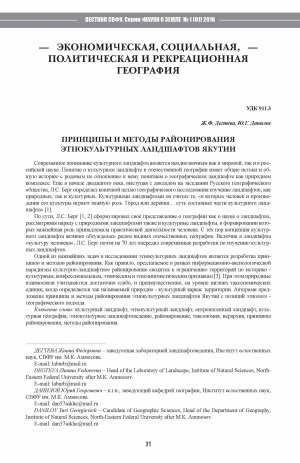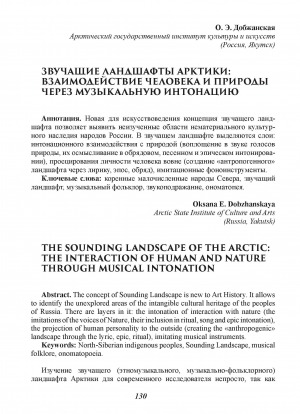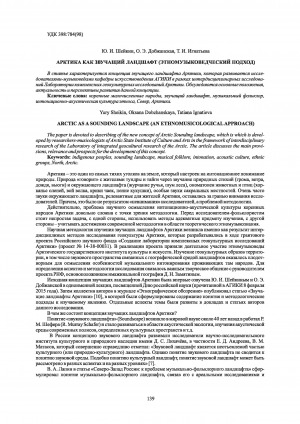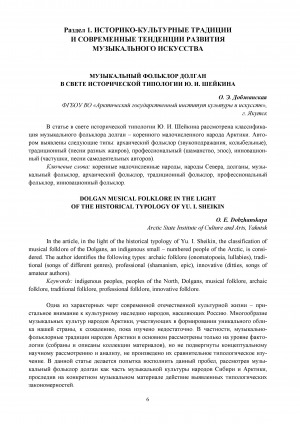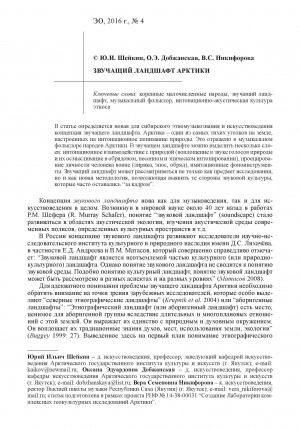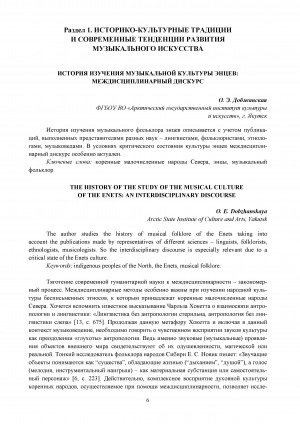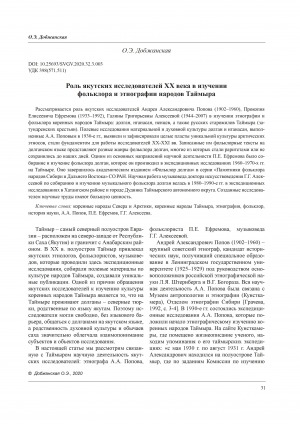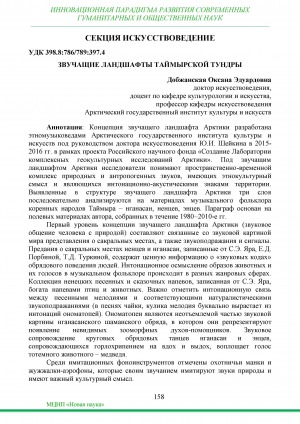
Звучащие ландшафты Таймырской тундры = The sounding landscapes of Taimyr tundra
Статья в журнале
Русский
398.8(571.511)
культурная география; звучащий ландшафт; музыкальный фольклор; коренные народы Севера; коренные народы Таймыра; ненцы; нганасаны; энцы; cultural geography; sounding landscape; musical folklore; indigenous peoples of the North; indigenous peoples of Taimyr; Nenets; Nganasans; Enets
С. 158-162
Инновационная парадигма развития современных гуманитарных и общественных наук: сборник статей международной научно-практической конференции, состоявшейся 27 апреля 2020 г. в г. Петрозаводске
Петрозаводск, МЦНП "Новая наука"
978-5-907327-31-3
Инновационная парадигма развития современных гуманитарных и общественных наук : сборник статей международной научно-практическойконференции, состоявшейся 27 апреля 2020 г. в г. Петрозаводске / под общей редакцией И. И. Ивановской. - Петрозаводск : МЦНП "Новая наука", 2020. - 167 с. : ил. ISBN 978-5-907327-31-3.
The concept of the Arctic sounding landscape was developed by ethnomusicologists of the Arctic State Institute of Culture and Arts under the guidance of doctor of Art History Yu. I. Sheikin in 2015-2016 as part of the project of the Russian Science Foundation "Creation of a Laboratory for Complex Geocultural Researches of the Arctic". Under the sounding landscapes of the Arctic, researchers understand the spatial-temporal complexes of natural and anthropogenic sounds that have some special ethno-cultural meanings and are intonation-acoustic signs of the territory. The three layers identified in the structure of the Arctic sounding landscape are consistently analyzed on the materials of the musical folklore of the indigenous peoples of Taimyr-Nganasan, Nenets, and Enets. The paragraph is based on the author's field materials collected from the 1980th to 2010th. The first level of the concept of the Arctic sounding landscape (sound communication between man and nature) consists of representations of sacred places associated with the sound picture of the world, as well as onomatopoeia and signals. Legends about the sacred places of the Nenets and Nganasan which were told by S. E. Yar, E. D. Porbina, and T. D. Turkina contain valuable information about the "sounding codes" of people's ritual behavior. The intonational interpretation of images of animals and their voices in musical folklore takes place in the different genres of musical folklore. A collection of Nenets songs and epic tunes recorded from S. E. Yar is rich, some melodies are songs of birds and animals. It is important to note the intonation connection between song melodies and the corresponding naturalistic onomatopoeia (in the songs of the gull and Sandpiper, the melody literally grows out of the intonations of onomatopoeia). Onomatopoeia are an integral part of the sound picture of the Nganasan shamanic rite, in which they represent the appearance of invisible zoomorphic helper spirits. The sound of circular ritual dances of Nganasan and Enets, accompanied by a throat-rasping breath in and out, embodies the voice of a totem animal – a bear. Among the imitation Phono-instruments, researchers described some hunting calling instruments and buzzers-aerophones, which imitate the voices of nature with their sound and have an important cultural meaning.
Добжанская, О. Э. Звучащие ландшафты Таймырской тундры / О. Э. Добжанская ; Арктический государственный институт культуры и искусств // Инновационная парадигма развития современных гуманитарных и общественных наук : сборник статей международнойнаучно-практической конференции, состоявшейся 27апреля 2020 г. в г. Петрозаводске / под общей редакцией И. И. Ивановской. - Петрозаводск : МЦНП "Новая наука", 2020. - 167 с. : ил. - С. 158-162.
Войдите в систему, чтобы открыть документ
